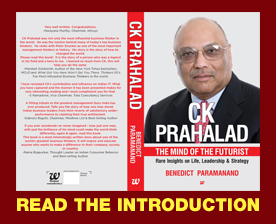 Business innovation that has significant social impact and is profitable at the same time is a dream blend very few companies are able to achieve. There are some exceptional companies that even do it repeatedly as if it is a habit. Tata Chemicals is one of them.
Business innovation that has significant social impact and is profitable at the same time is a dream blend very few companies are able to achieve. There are some exceptional companies that even do it repeatedly as if it is a habit. Tata Chemicals is one of them.
The list is long. It began with iodized salt to address iodine deficiency. It recently introduced fortified iron in Tata Salt to reduce anaemia. Tata Chemicals also invented a nano-technology-driven water purifier, an affordable and EPA-certified safe drinking water. The once dry, barren, and poverty stricken Mithapur village in Gujarat where the company started its operations, is now a vibrant ecosystem with the company’s strategic business interventions.
Dr. Aarti Sharma caught up with Dr. Arup Basu, president of Tata Chemicals’ new businesses and innovation centre, to further understand how the company’s innovation culture has been built around social issues. Dr. Basu said Tata Chemicals’ sustainability consciousness towards communities has led to its dynamic innovation culture.
Today, Tata Chemicals is the world’s second largest producer of soda ash with manufacturing facilities in Asia, Europe, North America and Africa, with a turnover of Rs 13,800 crores.
Please tell us about the Tata Chemicals’ Innovation Centre
The Innovation Centre was set up during the 2005-2006 period acknowledging that the future would require us to focus on sustainability, and use resources in a calibrated manner. We have to address resource scarcity as more and more people move up the prosperity curve. So, we set up the innovation centre based on themes of sustainability and green chemistry. We recognized business potential in two domains -first on the natural resources side, it was nanotechnology that lies at the intersection of physics and chemistry. The second, biotechnology, is at the intersection of chemistry and biology.
How is nanotechnology adding value to your sustainability theme?
We view nanotechnology as a platform to magnify and sometimes even modify product attributes. We want to use it to improve product attributes such that one can do more with less. For example, how can we use smaller sized Titanium Dioxide or Zinc Oxide particles in industrial formulations such that the material requirement is far lower and yet the corresponding properties are far superior? This doing more with less stems from the reality that natural resources are scarce, not abundant.
Are concerns around resource constraints driving your sustainable business innovation model?
Well, our choices are driven by this view. When you look at Mithapur, we have created a chemical complex which does not create stress on fresh water which is scarce there. We don’t use ground water.
We want our community to use fresh water to meet their needs rather than for our industrial use. We have introduced rainwater harvesting in the community. And to meet our business needs, we take sea water, reuse and recycle it, and reduce its usage. That way, we earn the right to co-exist.
When did sustainability consciousness arise within Tata Chemicals?
It existed since inception. We intuitively understand sustainability. We have a cement plant whose raw material is a solid waste of our soda ash process. We are not a cement company, but we run the cement plant. We take a holistic, life cycle view of operations and products, and work towards zero waste. Our first instinct is to evaluate potential of any by-product as a raw material for another product.
But why invest corporate resources on a waste? Why diversify in an area which is not the core focus of your business?
Many people looked at our strategy and said you should not be in cement when you are a chemical company. After all, we are known as Tata Chemicals! It’s perfectly fair thinking from a blinkered strategy perspective. However, on adopting a sustainability lens, a different view emerges. For us, the cement plant is a vehicle to run a cleaner ship and so it matters.
Is Tata Chemicals investing in such practices to attain higher reputation?
We don’t chase reputation. We chase what we believe is the right and proper thing to do. If we have a good reputation, that’s a happy by-product. For us, it is about value. What do we stand for? When a consumer is buying something from us, it’s important that the consumer knows what we stand for. So, if you will take our salt, you will have no issue with our Iodine content. Our product value proposition is linked to our company value proposition and what we stand for. This relationship has to endure for any business to be sustainable.
Dr. Aarti Sharma is an international
corporate sustainability and sustainable
development strategist. She is the
founder of Sustainable Value Alliance
sustainablevaluealliance.org
aarti@sustainablevaluealliance.org












Recent Comments